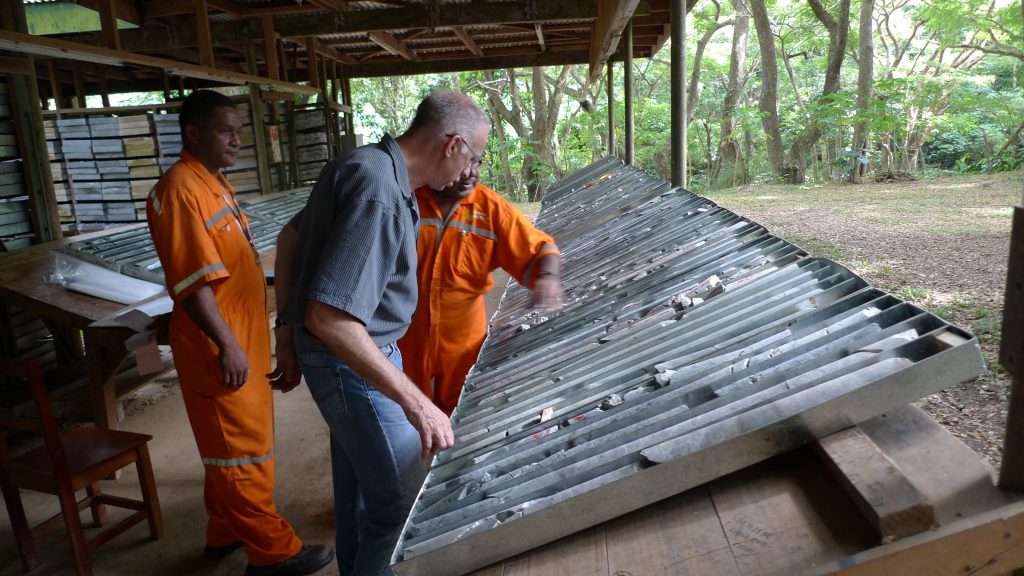Lion One Metals drills 87.83 g/t gold over 1.5 metres at Tuvatu, Fiji

Lion One Metals Ltd.‘s [LIO-TSXV; LOMLF-OTCQX; LY1-FSE] drilling has returned multiple high-grade intercepts, significantly extending the drill-confirmed vertical extent of deep feeder zone 500 and further confirming the alkaline deposit model and depth potential of the 100%-owned, fully permitted Tuvatu alkaline gold project located on the island of Viti Levu in Fiji.
The latest drilling at Tuvatu extends deep feeder zone 500 approximately 300 metres below the base of the current resource, with two further holes intersecting high-grade mineralization an additional 350 metres deeper, demonstrating vertical continuity of the Tuvatu gold system of at least 1,150 metres. The recent drilling comprised 11 drill holes for 9,113.4 metres of drilling.
Top intercepts included 23.14 g/t gold over 3.0 metres, including 118.6 g/t gold over 0.3 metres from 571.5 metres in hole TUG 138. Hole TUDDH 573W1 returned 25.83 g/t gold over 2.7 metres, including 43.64 g/t gold over 0.3 metres from 582.5 metres. Hole TUG 136 returned 87.83 g/t gold over 1.5 metres, including 108.41 g/t gold over 0.6 metres from 445.1 metres.
This deep extensional drilling not only demonstrates exceptional grades at depth, but further confirms the potential for a deep-rooted gold bearing alkaline gold system like the example at the nearby Vatukoula gold system in Fiji where historical gold production exceeds seven million ounces and exploration (and gold production) is ongoing.
Sergio Cattalani, Lion One’s senior vice-president of exploration, commented: “With the completion of the re-entry hole TUDDH-494, high-grade mineralization in the deep feeder zone 500 has now been demonstrated to extend for over 650 metres vertically below the base of the current resource. Within this interval, bonanza grades over realistic mining widths have been confirmed and modelled as multiple subparallel to locally interconnected lodes with highest grades forming a steeply (approximately -80Ëš) northeast-plunging shoot of about 200 metres wide, by about 90 metres thick, and approximately 300 metres vertically below the overlying resource. While this upper 300-metre portion of the feeder zone alone should add significantly to the overall resource at Tuvatu, the lower 350 metres remains essentially undrilled.”
Results of 11 drill holes (totalling 9,113.4 m) are reported on the company’s website.These results follow previously reported drilling that totaled 17 drill holes, that had partially defined the presence of a deep high-grade feeder structure, beginning with the discovery by hole TUDDH500 announced in July, 2020. Discovery hole TUDDH500 and two subsequent wedge holes drilled into the mineralized structure at a low angle to its strike returned outstanding results, including 12.7 metres at 55.43 g/t gold from a 571.0-metre depth, including 4.7 metres at 144.81 g/t gold in hole TUDDH500; 3.3 metres of 85.7 g/t gold from 591.6 metres depth, including 0.3 metres at 305 g/t gold and 0.3 metres at 310 g/t gold in TUDDH500W1; and 6.5 metres at 7.32 g/t gold from 674.0 metres depth, including 0.5 metres at 67.40 g/t gold in TUDDH500W2.
Subsequent drilling was reoriented to intersect the mineralized structure at higher angles of incidence yielding more realistic thicknesses of individual lodes (for example: 2.30 m at 55.44 g/t gold from 575.7 metres depth, including 1.32 metres at 96.13 g/t gold in TUDDH533; 1.80 metres at 34.8 g/t gold at 629.3 metres depth, and 2.40 metres at 24.31 g/t gold from 632.3 metres depth, in hole TUDDH544W2; 3.47 metres at 20.71 g/t gold from 703.7 metres depth, including 0.23 metres at 294.5 g/t gold in TUDDH514). Drill testing across the strike direction of the mineralized structure has also led to the discovery and subsequent testing of additional sub-parallel structures.
The ongoing deep drill program is designed to test the strike extent, and down-dip continuity of the high-grade mineralized structure, as well as to test for the presence of additional sub-parallel mineralized lodes.
Lion One envisions a low-cost high-grade underground gold mining operation at Tuvatu coupled with exciting exploration upside inside its tenements covering the entire Navilawa Caldera, an underexplored, yet highly prospective, 7-km-diameter alkaline gold system.
